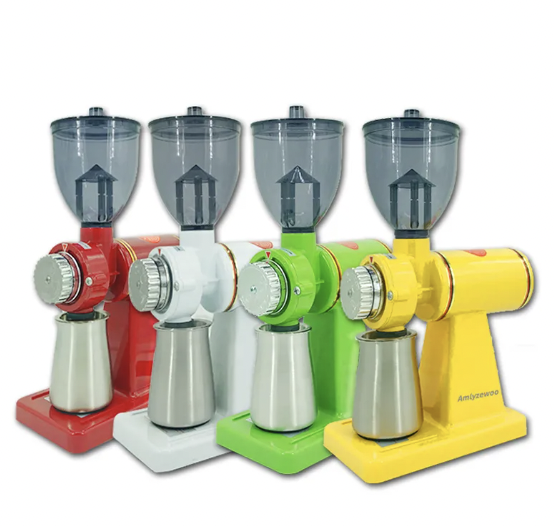يُقال بين عشاق القهوة: "المطحنة أكثر أهمية من آلة القهوة". قد يبدو هذا مفاجئًا، لكنه في جوهره صحيح. يمكنك امتلاك أفضل حبوب قهوة في العالم، والأكثر تحميصًا طازجة، ولكن إذا قمت بطحنها بشكل رديء، فلن تتمكن أبدًا من استخلاص إمكاناتها الكاملة. إن المفتاح للحصول على قهوة استثنائية في المنزل ليس آلة إسبرسو بقيمة 3000 دولار، بل مطحنة بور (burr) عالية الجودة.
سيقودك هذا الدليل خلال كل ما تحتاج إلى معرفته لاختيار مطحنة البور المثالية وفقًا لاحتياجاتك الخاصة، وميزانيتك، وأساليب تحضير القهوة التي تستخدمها. سنذهب بعيدًا عن ضجيج التسويق ونركز على العوامل العملية والتقنية والتجريبية التي تُحدث فرقًا حقيقيًا.
لماذا مطحنة البور؟ الأساس في النكهة
قبل أن نتعمق في الـ"كيف"، دعونا أولًا نوضح سبب الأهمية. هناك نوعان رئيسيان من مطاحن القهوة: مطاحن الشفرات ومطاحن البور.
مطاحن الشفرات: تستخدم هذه الأدوات شفرة تشبه المروحة لتقطيع الحبوب بشكل عشوائي وغير متسق. والنتيجة هي مزيج من كتل كبيرة وجزيئات متوسطة وغبار ناعم. عند تحضير القهوة، يؤدي هذا الطحن غير المنتظم إلى الاستخلاص الناقص (من القطع الكبيرة، ما ينتج نكهات حامضة وضعيفة) والاستخلاص الزائد (من الغبار الناعم، ما ينتج نكهات مرة وحادة). وهذا يشوش على الطابع الحقيقي للقهوة.
مطاحن الحبيبات: تعمل هذه الأدوات على سحق الحبوب بين سطحين خشنين (القرصين). والميزة الأساسية هي أن المسافة بين القرصين قابلة للضبط بدقة، مما يحدد حجم جزيئات الطحن. وينتج عن ذلك طحن متسق ومتجانس . التجانس هو السر في استخلاص متوازن، حيث تذوب جميع السكريات اللذيذة والحموض والزيوت العطرية في فنجانك بنفس المعدل، ليُظهر ملف نكهة الحبة كما صُمم.
الخلاصة: إذا كنت جادًا بشأن القهوة، فإن مطحنة القرص ليست خيارًا؛ بل هي أول استثمار تقوم به وأهم استثمار على الإطلاق.
الخطوة 1: افهم النوعين الرئيسيين للقرصين
قلب أي مطحنة هو مجموعة القرص المخرش. يلعب نوع القرص المخرش دورًا كبيرًا في أداء المطحنة ومستوى الضجيج والتكلفة.
1. الأقراص المخروطية
التصميم: يتم وضع قرص مخرش على شكل مخروط داخل قرص خارجي على شكل حلقة. تُغذى الحبوب من خلال المركز وتُسحق أثناء تحركها لأسفل عبر الفجوة المتناقصة.
-
المزايا:
عادةً ما تكون أقل تكلفة.
عادةً ما تكون أبطأ، مما يقلل من تراكم الحرارة (يمكن أن تحرق الحرارة القهوة وتتلف العطور الطيارة).
غالبًا ما تكون أكثر هدوءًا بالمقارنة مع الأقراص المسطحة.
أقل عرضة للانسداد عند استخدام حبوب زيتية.
-
العيوب:
قد تنتج طحنًا أقل انتظامًا نسبيًا مقارنة بالأقراص المسطحة عالية الجودة، على الرغم من وجود نماذج ممتازة.
2. الأقراص المسطحة
التصميم: يتم وضع قرصين متوازيين على شكل حلقة وجهاً لوجه. يدور أحدهما بينما يبقى الآخر ثابتًا. تُغذى الحبوب من المركز وتُدفع إلى الخارج بفعل القوة الطاردة المركزية أثناء الطحن.
-
المزايا:
معروف بإنتاجه طحناً موحداً وثابتاً جداً، مما قد يؤدي إلى وضوح وفصل أكبر في النكهة.
غالباً ما يكون أسرع من مطاحن الطحن المخروطية.
-
العيوب:
عادةً ما يكون أكثر تكلفة.
قد يولد حرارة وضجيجاً أكثر بسبب السرع العالية (RPMs).
قد يكون من الصعب تنظيفه ويكون أكثر عرضة للانسداد بالحبوب الزيتية.
أيهما يجب أن تختار؟ بالنسبة لمعظم المستخدمين المنزليين، فإن مطحنة طحن مخروطية ذات جودة جيدة هي خيار ممتاز وموثوق. إذا كنت هاوٍ دقيقاً تسعى لتحقيق أقصى درجات وضوح النكهة والتوحيد في التقطير أو الإسبريسو، وسمحت لك الميزانية، فإن مطحنة الطحن المسطحة عالية الجودة تعد استثماراً جديراً بالاهتمام.
الخطوة 2: حدد طريقة التخمير واحتياجات نطاق الطحن
هذه هي الخطوة الأكثر أهمية في عملية اتخاذ قرارك. تتطلب طرق التخمير المختلفة أحجام طحن مختلفة بشكل كبير. يجب أن تكون المطحنة الخاصة بك قادرة ليس فقط على تحقيق هذه الأحجام، بل أيضاً على التعديل الدقيق ضمنها.
الإسبريسو (طحن ناعم): هذا هو الاستخدام الأكثر تطلباً. وهو يتطلب طحناً ناعماً جداً يشبه البودرة، والأهم من ذلك، التعديلات الدقيقة . يمكن أن يكون الفرق بين لقطة مثالية مدتها 25 ثانية ولقطة حامضة أو مرة هو جزء بسيط من دورة على مؤشر الطحن. يجب أن يكون مطحونك قابلاً للتعديل الدقيق والدقيق جدًا.
التصفيح / القطرة (طحن متوسط): هذا يتطلب طحنًا متسقًا ومتوسطًا، مشابهًا للرمل الخشن. وعلى الرغم من أن هذا ليس متطلبًا مثل الإسبريسو، إلا أن القدرة على إجراء تعديلات صغيرة تظل ضرورية لتحقيق الوقت المثالي للتحضير والتوازن المثالي في النكهة.
الضغط الفرنسي / التخمير البارد (طحن خشن): هذا يتطلب طحنًا خشنًا متسقًا، مشابهًا لملح البحر. التحدي الرئيسي للمطاحن هنا هو تجنب الجسيمات الدقيقة (جزيئات غبارية صغيرة) التي يمكن أن تتسلل عبر شبكة الفلتر وتجعل القهوة عكرة.
فخ المطحنة متعددة الأغراض: احذر من المطاحن التي تدعي أنها تقوم بـ"الإسبريسو إلى الضغط الفرنسي" ما لم تكن مصممة خصيصًا لذلك (مثل Baratza Encore ESP أو Fellow Opus). فكثير من المطاحن الحجرية من الفئة المبتدئة لها نطاق تعديل خشن جدًا للحصول على إسبريسو مناسب، أو تنقصها السيطرة الدقيقة اللازمة لضبطها بدقة.
الخطوة 3: الميزات الرئيسية التي يجب تقييمها
بمجرد أن تتعرف على نوع القرص الدوار والمدى المطلوب للطحن، فقد حان الوقت لمقارنة الميزات.
1. اتساق الطحن (المقياس الأهم)
هذه هي الوظيفة الأساسية لمطحنة القهوة. اقرأ المراجعات الاحترافية وآراء المستخدمين لمعرفة مدى انتظام الطحن بالنسبة لطريقة التخمير التي تنوي استخدامها. ابحث عن صور للبن المطحون إن أمكن.
2. القابلية للتعديل
التعديلات المتدرجة: تُقفل غرفة الطحن بين إعدادات محددة مسبقًا (مثل 1-40). هذا جيد لإمكانية التكرار، لكنه قد يكون محدودًا عند تحضير الإسبريسو، حيث قد تحتاج إلى إعداد بين الرقمين 5 و6.
التعديلات غير المتدرجة: تسمح بتعديلات لا نهائية بين الإعدادات. هذه هي المعيار الذهبي لتحضير الإسبريسو، لأنها تعطيك تحكمًا كاملاً. ومع ذلك، قد يكون من الصعب إعادة نفس الإعدادات إذا كنت تنتقل باستمرار بين طرق تخمير مختلفة.
3. الطحن حسب الطلب مقابل الطحن باستخدام الخزان
الطحن حسب الطلب (بدون خزان) يتم تخزين الحبوب في وعاء مغلق بإحكام، ويتم طحنها فقط عند تفعيلك للجهاز. هذا أمر مثالي لتقليل بقاء البقول المطحونة وحفظ نضارة حبوبك الكاملة. شائع في المطاحن الفاخرة والتجارية.
مخزن الطحن: يقع مخزن شفاف من البلاستيك أو المعدن في الأعلى، ويحتوي على الحبوب. وعلى الرغم من سهولة الاستخدام، فإن الحبوب التي تُترك في المخزن تتعرض للضوء والهواء، مما يؤدي إلى فقدان نضارتها بشكل أسرع. مناسب أكثر للأسر التي تستهلك القهوة بسرعة كبيرة.
4. الثبات والاحتفاظ
الاحتفاظ: يشير هذا إلى كمية القهوة المطحونة التي تعلق داخل المطحنة. يُعد الاحتفاظ المنخفض مؤشرًا على أنك تحصل على معظم القهوة التي قمت بطحنها حديثًا، مع وجود كمية أقل من القهوة القديمة والفارغة من الجلسة السابقة المختلطة بها.
الشحن الكهربائي الساكن: يمكن أن تُنتج القهوة المطحونة كمية كبيرة من الكهرباء الساكنة، مما يجعلها تلتصق بمخرج المطحنة ووعاء جمع المسحوق. بعض المطاحن تحتوي على تقنيات مضادة للشحن الكهربائي (مثل تصميم Baratza "وعاء المسحوق" أو جهاز التأين في مطحنة Fellow Ode) التي تقلل بشكل كبير من هذه الظاهرة المزعجة.
5. مستوى الضجيج
مطاحن الحبوب الدوارة ليست صامتة. ومع ذلك، فإن المطاحن المخروطية الأحادية التي تدور ببطء تكون عادةً أكثر هدوءًا مقارنةً بنماذج المطاحن المسطحة عالية السرعة (RPM). إذا كنت تعيش في منزل يضم أشخاصًا نائمين، فهذه نقطة تستحق التفكير.
6. جودة البناء والمتانة
ابحث عن المطاحن ذات الهيكل المعدني أو البلاستيكي عالي الجودة والمتين. تشتهر أفضل العلامات التجارية (مثل Baratza) بإمكانية إصلاحها، حيث توفر قطع الغيار وأدلة الإصلاح لتمديد عمر المطحنة لعقود.
الخطوة 4: حدد ميزانيتك واستكشف التوصيات
الميزانية: أقل من 100 دولار
التركيز: مطاحن حبوب مخروطية مبتدئة قادرة على تحضير القهوة بالتنقيط أو الصب اليدوي.
التوصية: Baratza Encore. إنها البطلة المطلقة في هذه الفئة. فهي تقدم جودة طحن ممتازة مقابل سعرها، وتتمتع بمتانة استثنائية، ويمكن إصلاحها بالكامل. وهي نقطة بداية مثالية لأي شخص يتخلى عن مطاحن الشفرات.
متوسطة المدى: 100 - 250 دولارًا
التركيز: تحسين الاتساق، وميزات إضافية، والدخول إلى تحضير الإسبريسو.
-
التوصيات:
Baratza Encore ESP / Fellow Opus: مصممة خصيصًا لطحن جميع الأغراض، بما في ذلك الإسبريسو. وتتميز هذه الأجهزة بنظام تعديل خاص يوفر التحكم الدقيق اللازم لضبط كمية القهوة بدقة.
DF64 (أو ما يعادلها): مطحنة مُغيّرة للقواعد تجلب شفرات مسطحة بحجم 64 مم من الفئة التجارية إلى نطاق سعر المستخدمين المنزليين. ويُقدَر أداؤها وإمكانية تعديلها من قبل عشاق الإسبريسو.
عالية المستوى: 250 دولارًا فأكثر
التركيز: أقصى درجات اتساق الطحن، والسرعة، والمتانة، والأداء المتخصص.
-
التوصيات:
Baratza Vario / Forte: مطاحن مسطحة ممتازة تُعرف باتساق أدائها عبر نطاق واسع.
سلسلة Eureka Mignon: جرارات عمل إيطالية الصنع، تُعتبر غالبًا أفضل مطاحن الإسبريسو المخصصة من حيث القيمة.
نيش زيرو: مطحنة ثورية ذات مجارش مخروطية وتقريبًا بدون احتفاظ بالحبوب، يُحبها المستخدمون لبساطتها وتشغيلها الهادئ وقدرتها على التبديل بين طرق التخمير بسهولة.
الخلاصة: طريقك نحو فنجان مثالي
اختيار أفضل مطحنة مجارش هو رحلة شخصية تعتمد على عاداتك في التخمير وتوقعاتك من النكهة وميزانيتك. لا تضيع في المواصفات وحدها. تذكّر تسلسل الأولويات:
اتساق الطحن: هذا شرط لا يقبل التفاوض.
نطاق الطحن المناسب: تأكد من أنها قادرة على التعامل مع طريقتك الأساسية في التخمير.
الميزات وسهولة الاستخدام: خذ بعين الاعتبار الضوضاء والاحتفاظ بالحبوب وسهولة التنظيف.
الميزانية والقيمة: استثمر بقدر ما يمكنك تحمله بشكل معقول، لأن المطحنة الجيدة تدوم لسنوات.
باتباعك لهذا الدليل، فأنت لا تشترِ مجرد جهاز كهربائي فحسب، بل تستثمر في المفتاح الذي يفتح الإمكانات الحقيقية واللذيذة المختزنة داخل كل حبة قهوة. سيشكرك أنت في المستقبل، وأنت تستمتع بكوب قهوة متوازن تمامًا وبنكهات دقيقة.




